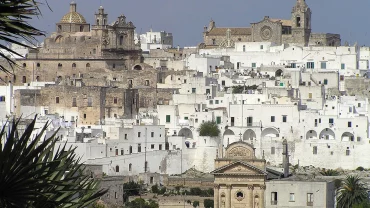The tower was called “of the reeds” because it was located near a vast reedbed.
The hamlet of Torre Canne takes its name from a watchtower dating back to the 16th century, built to protect the coastline from Turkish raids. The tower was called “of the reeds” because it was located near a vast reedbed. The old part of Torre Canne, originally a modest fishing village, is located near the lighthouse and the characteristic limestone cliff.
A little further south in a sandy cove gush forth the “Waters of Christ,” so named for their therapeutic action. Thanks to the presence of these waters Torre Canne has slowly developed into a popular tourist destination for mud-balneotherapy and balneotherapy treatments.
For over a century that Torre Canne has not only been famous for its beaches with clear waters and fine sand. In fact, for more than a hundred years, the thermal phenomena that characterize the subsoil of the Apulian resort have been known to experts and exploited for the health and well-being of the body. At what, today, are the Torre Canne Thermal Baths, there are as many as 11 springs generated by underground streams with innumerable virtues that make this area of Puglia a perfect destination not only for beach tourism but also for wellness tourism. The spas, a stone’s throw from the sea, care for the health and beauty of their guests by offering state-of-the-art facilities and treatments based on the exploitation of beneficial waters and mud from the bowels of the earth.
In the middle of a park of tamarisk and conifer trees is the thermal pond from which mud is extracted for therapeutic use. The sludge is composed of calcium silicate, alumina and iron with magnesium in small amounts, and iodine. The beautiful hamlet of Fasano, in the province of Brindisi, is crisscrossed by underground streams of thermal water gushing from 11 springs that make the Terme di Torre Canne a true temple of wellness.
Two of the 11 pools at the Torre Canne hot springs have been particular objects of study from physical, chemical and therapeutic perspectives. It is about chicken no. 11, called Torricella, and Polla no. 3, named Antesana. Those that flow from the two springs are cold, rich waters that, because of the proportions of the salts dissolved in them, are called mildly brominated chloride-sulfate-sodium mineral waters. Their composition makes them particularly suitable for the treatment of inflammatory and contractural states. They also boast immune-stimulating, mucolytic, decongestant, eutrophic, keratoplastic, relaxing and metabolism-stimulating properties. But that’s not all because in the drainage channels and basins formed by the springs for millennia, deposits of mud have been formed which, thanks to maturation in thermal waters, also develop countless therapeutic properties. It is, in fact, a natural mix of clay and thermal water that matures within ponds that are also natural where beneficial springs flow. It is no wonder, then, that mud treatments are one of the flagships of the Torre Canne Spa.
In addition to the beaches and beautiful sea, there are many tourist attractions in the area, all located within a few kilometers of the town of Fasano. For example, 7 km from fasano is the renowned hamlet of Selva di Fasano, located in a panoramic position over the area of trulli and caves. The country is also home to one of the largest safari zoos in Europe, Zoo Safari Fasanolandia, a must-see destination for children.
The park is home to more than five hundred free-roaming exotic animals: lions, giraffes, zebras, Himalayan bears, llamas, African buffalo, dahlias, bison, flamingos, and monkeys. For lovers of good food, there is also no shortage of food and wine itineraries and routes.






Comment (0)